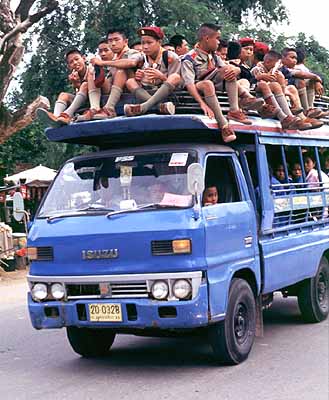 Image via Wikipedia
Image via Wikipedia
Here's a news release I received from the tourism board of Western Australia which includes the areas of Perth and Fremantle
Most travelers to the land down under opt for Sydney, the great barrier reef, and Melborne, but the south west coast comes alive with the Australia of years past, where folks on the street still greet you with 'hey mate.' Read on for more details:
A place of stunning natural beauty and an authentic indigenous frontier culture. The country’s largest state, Western Australia is the size of all of Western Europe, yet has a population of just 2.1 million people—75 percent live in the capital city of Perth. This means the countryside is brimming with unspoiled wilderness and boasts some of the most magnificent natural wonders, "Down Under".
 Image via Wikipedia
Image via Wikipedia
From undulating sand dunes to tropical gorges to stunning Outback landscapes and the largest freshwater lake in the Southern Hemisphere, Western Australia is truly the “Real Australia.”
Travelers seeking an authentic “Aussie” experience incorporating romantic luxury, outdoor adventure, an introduction to Aboriginal culture.
The capital city of Perth is vibrant and culturally rich, yet manages to retain the familiarity and friendliness of a small town. Located on the banks of the tranquil Swan River, with 50 miles of white sand beaches within 15 minutes of the Central Business District, Perth is a a magnet for outdoor enthusiasts.
The city boasts a mild year-round climate and receives more hours of sunshine than any other Australian capital city—making it the perfect place to enjoy a day of sailing, wind- or kite surfing, kayaking, surfing, or swimming at legendary seaside spots such as Cottesloe or Scarborough.
Alternatively, visitors can enjoy a stroll and a picnic in the botanical gardens at King’s Park—the world’s largest green space within a major city in the world—or board a ferry to South Perth and take in the view of the city’s famous skyline. Another can’t-miss is the unforgettable sight of daybreak over Perth, when the sun rises out of the Indian Ocean and reflects off of the city’s dazzling glass and steel skyscrapers. In addition to its fantastic outdoor offerings, Perth is also home to numerous cultural attractions—from the renowned indigenous art collection at the Art Gallery of Western Australia to the trendy boutiques and galleries of the Subiaco neighborhood as well as on Murray and King streets.
 Image via Wikipedia
Image via Wikipedia
Visitors can also experience the city’s lively arts and music scene in the diverse array of bars, clubs, and pubs in the Leederville, Mount Lawley, and Northbridge neighborhoods. For the gastronome, Perth’s restaurants encompass everything from funky to fine dining, with special emphasis on the region’s premium produce, seafood, artisan foods and award-winning Western Australian wines.
The greater Perth region offers additional attractions just an hour’s drive from the city center. Visitors can enjoy a weekend at a boutique guesthouse to explore the farm trails and vineyards of the peaceful Swan Valley; take a bushwalk in one of several national parks in the Darling Range to catch glimpses of the native wildlife; or go hot-air ballooning or sky diving in the Avon Valley. Rottnest Island, affectionately known as “Rotto,” a popular holiday spot located just offshore from Perth. Rotto is a car-free island only trafficked by bikes and pedestrians, and is the perfect place for sunbathing, fishing, or snorkeling above shipwrecks in crystal clear waters.
The Coral Coast: North of Perth lies Western Australia’s fabled Coral Coast 1000 km of pristine, white-sand beaches and warm, turquoise waters that make for world-class snorkeling and scuba diving. Perhaps one of the most famous destinations for visitors desiring a close encounter with nature is at Monkey Mia, located within the Shark Bay Marine Park, a World Heritage-designated coastline. Here, wild bottlenose dolphins make daily visits to the clear shallows of the bay, enchanting visitors with their gregariousness and playful behavior.
Surfers flock to the region, especially to the town of Geraldton, which provides consistent waves suitable for novices to experienced wave riders, and to Kalbarri, which is famous for its big, left-hand breaks at Kalbarri. Inland from the coast, the Kalbarri National Park abounds with bush-walking and abseiling opportunities for those looking for non-aquatic pursuits.
Another highlight of the region is the Ningaloo Reef. Located on the Northwest Cape section of the coast, the reef begins near Coral Bay, nearly 800 miles north of Perth, and ends 160 miles later at the beach town of Exmouth. Now a national marine park, Ningaloo is one of the world’s best-preserved and largest fringing coral reefs, covering an impressive 2,500 square miles. It is home to 500 species of tropical fish and 220 species of coral, and visitors don’t need scuba certification to explore the reef. Located just offshore, Ningaloo Reef is ideal for even first-time snorkelers and the lack of crowds, accessibility, and consistently beautiful weather, make the reef a haven for underwater enthusiasts. While manta rays and dolphins frequent the reef, from April to July it’s also possible to swim alongside whale sharks, the largest fishes on earth. Although they can reach up to 60 feet in length, these gentle creatures feed only on plankton.
 Image via Wikipedia
Image via Wikipedia
For more info:

![Reblog this post [with Zemanta]](http://img.zemanta.com/reblog_e.png?x-id=8c432c06-80b5-4a7c-bcb4-c107372fef8a)















![Reblog this post [with Zemanta]](http://img.zemanta.com/reblog_e.png?x-id=e4ee9a7c-1cf6-4814-85c2-96a69ad67923)












![Reblog this post [with Zemanta]](http://img.zemanta.com/reblog_e.png?x-id=8f7abd62-4c9a-48c5-9dbf-47a7853564b2)












